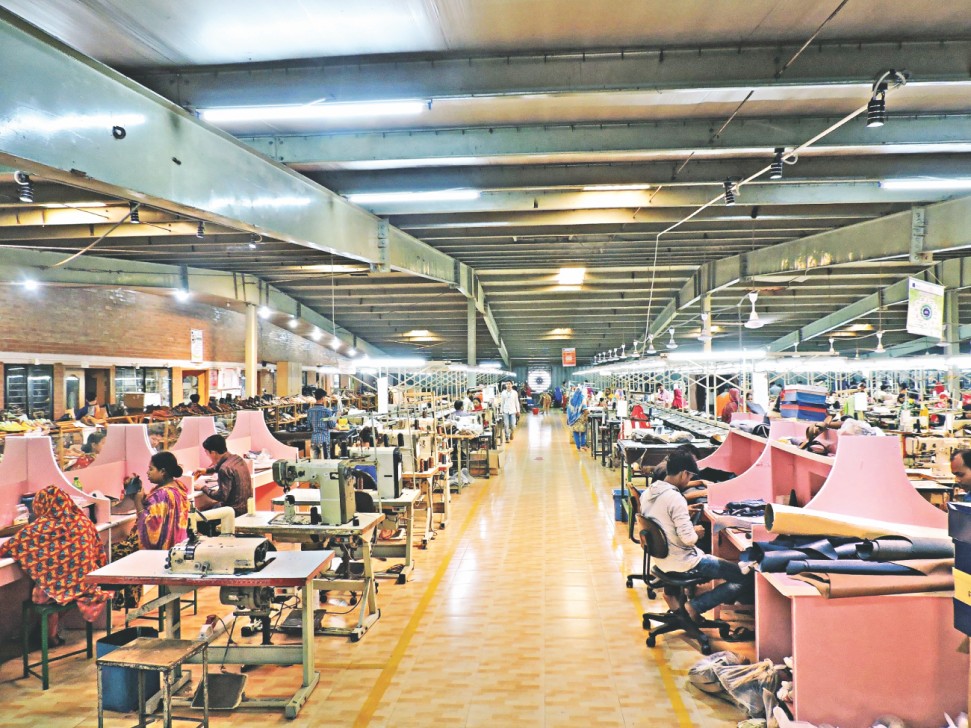Leather goods exports dull despite huge potential

Vietnam entered the global footwear export market just a decade ago and the Southeast Asian nation’s export now stands at $20 billion a year. On the other hand, Bangladesh made the foray three decades ago but its overseas shipment in the segment is hovering around $1 billion despite having the main raw material and human resources.
A lack of backward linkage industries, inconsistent policies, lengthy customs procedures, and harassment in getting bonded warehouse facility for imports of raw materials are mostly blamed for the low leather goods exports from Bangladesh, said Nasir Khan, chairman and managing director of Jennys Shoes, one of the pioneers in manufacturing and exporting of footwear.
“But Bangladesh is capable of increasing its leather and footwear exports to $10 billion by 2025 if the authorities such as the National Board of Revenue and the port authority as well as banks extend cooperation to exporters,” he said in an interview with The Daily Star recently.
He said exporters have to import almost all the raw materials except raw leather and it increases the lead time for exports. Customs officials also do not allow to import raw materials needed for a year at a time.
“So, we have to import items in phases and it takes too much time to produce finished goods and export as well,” he said.
Nasir Khan
Khan’s journey as a leather and footwear sector entrepreneur began at the same time Bangladesh ventured out into the highly competitive global market.
After graduating in system engineering from Japan in 1989, he came back to Bangladesh with the hope of becoming an entrepreneur. He started with the trading of leather before choosing to be a footwear manufacturer and exporter. He set up a factory in 1992.
His inspiration came from Manzur Elahi, the legendary figure in Bangladesh’s footwear sector.
Khan says he was the first Bangladeshi to have explored the sensitive Japanese market for leather and footwear goods.
At home, the leather and footwear sector is playing second fiddle to the garment sector although exporters in both sectors began selling their produce internationally within a gap of a few years.
Apparel accounted for 80 percent, or $40 billion, of the national exports in fiscal 2018-19, whereas the shipment of footwear and other leather goods brought $1 billion. Of the sum, the footwear sector bagged $608 million, up from $565 million a year ago.
There are about 60 local companies, including Apex Adelchi Footwear, Jennys Shoes and Bay Footwear, which export footwear and leather goods. The destinations are mainly Japan, Europe and the US to some extent.
Khan said his export came down to $8 million from $15 million just two years ago because of a lack of cooperation from the customs department. One of his production units has remained unused as the authorities have been delaying to renew the bonded facility since 2017.
“This type of complexity discourages high-end buyers such as Nike, Reebok and Puma to source from Bangladesh.”
He, however, hails the vision of the government on the footwear and leather sector as it is formulating a “Leather and Leather Goods Development Policy” to raise export earnings to $5 billion.
“The policy alone can’t achieve the target unless the government becomes cooperative with the exporters and understands their needs,” he said.
Bangladesh’s leather and footwear sector is failing to make it big internationally despite having the main raw material and skilled workforce.
“The sector has three decades of experience which can help the sector boom, but that is not happening,” he said.
The country can use only 30 percent of its finished leather. The remaining 70 percent is exported, mostly to China.
Khan said Bangladesh can earn three times more from exports of leather goods if all the finished leather produced locally is utilised.
Finished leather exports fetch less than a third of a footwear item: one square foot of finished leather brings only $0.60 whereas footwear made from three square feet of finished leather hauls in $5. Bangladesh produces 400 million square feet of finished leather annually.
Presently, Bangladesh has around 165 footwear and leather factories and they could fetch up to $5 billion in exports receipts were they compliant and used modern technologies, Khan said.
According to the entrepreneur, many Chinese companies are keen to invest in Bangladesh’s leather and footwear sector and relocate their manufacturing units to the country to avoid extra tariffs that emerged from the US-China trade war.
Already some Chinese companies have set up factories in Bangladesh and started exporting from the country in order to avoid the rising production costs at home, he said.
“The geographical location of Bangladesh is also very favourable for export and import.”
He advises new entrepreneurs to adopt technology and use high-quality products to explore new markets.
The global footwear market was valued at $246 billion in 2017 and is expected to reach $320 billion by 2021.
“So, there is huge potential for the new entrepreneurs,” he said, adding Tk 20 crore is enough to start a factory with a capacity to produce 1,000 pairs of shoes a day.
